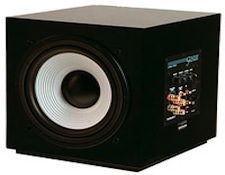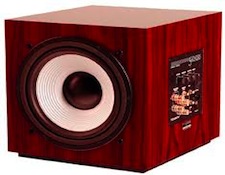It’s the time of year for saving money!
 The first reason should be obvious – nothing goes BOOM better than a subwoofer.
The first reason should be obvious – nothing goes BOOM better than a subwoofer.
Sure, there are full-range planar speakers, such as the fabled SoundLabs A-3 (with the optional solid wood wings) that could produce substantial energy at 30 Hz and even generate a little something around 16 Hz during the Frank Symphony in D minor. But you better have a big room. I borrowed J. Gordon Holt’s SoundLab A-3 speakers for almost six months between a pair of Original Apogee Full Ranges and Dunlavy SC-VI speakers. Those SoundLab A-3 speakers with the optional wings were a physical “wall of sound” that needed at least twelve feet of lateral space merely to line up all six panels! Add in some room for a couple of power amplifiers plopped in the middle and you’ve got a system that needs a space with at least twenty feet of lateral expanse. At the time I had that.
 But I digress. Subwoofers can do bass in a far less physically obtrusive manner than a full-range speaker can. You can even use multiple mono subwoofers placed strategically in your listening room to even out the bass room nodes, as I do in the room with my Dunlavy system. Even though the Dunlavy SC-VI speaker has a measured response down to 25 Hz (due in part to two 15″ drivers), I prefer to cross over into two (or more) Genesis G-928 and Snell subwoofers at 55 Hz.
But I digress. Subwoofers can do bass in a far less physically obtrusive manner than a full-range speaker can. You can even use multiple mono subwoofers placed strategically in your listening room to even out the bass room nodes, as I do in the room with my Dunlavy system. Even though the Dunlavy SC-VI speaker has a measured response down to 25 Hz (due in part to two 15″ drivers), I prefer to cross over into two (or more) Genesis G-928 and Snell subwoofers at 55 Hz.
I like mid-power (100 to 150 watts per channel) as opposed to high power (250 to 500 watts per channel), power amplifiers because they cost less and usually deliver the same or sometimes even better sonics than their beefier big brothers. They are also, generally, much easier to carry around.
]]> Obviously, the primary disadvantage of a mid-power amp is that is can occasionally, when subjected to the rigors of reproducing a full-range signal, clip. By using a crossover so the amp never sees low-frequency energy demands, it won’t clip as readily because it doesn’t need as much power to amplify the rest of the frequency spectrum.
Obviously, the primary disadvantage of a mid-power amp is that is can occasionally, when subjected to the rigors of reproducing a full-range signal, clip. By using a crossover so the amp never sees low-frequency energy demands, it won’t clip as readily because it doesn’t need as much power to amplify the rest of the frequency spectrum.
Which brings us to the second and 1/2 reason I like subwoofers – they relieve main speakers of the difficulties of having to try to reproduce low bass. By using a crossover, be it digital or analog, you relieve both your speakers and your power amplifier of the responsibility of having to deal with the power-draining low notes. It’s a twofer in that not only have you effectively boosted the power handling of your amplifier, but you’ve also reduced the strain on your main speakers – they don’t have to make the long excursions required to reproduce bass notes.
 Are there valid reasons for NOT using a subwoofer? Beside the obvious – if poorly implemented the sound could get worse – the issue of phase alignment and group delay of lower frequencies are the primary problems facing any subwoofer installation. Subwoofers in sealed enclosures or open baffles rather than ported enclosures generally have less group delay and phase issues, but any subwoofer will, due to the laws of physics, have some potential discontinuities mating it with your main speakers. By choosing the lowest crossover point and a steep slope for the subwoofers’ upper frequency cut-off you can reduce these negative effects to a point where they cease to be an audible issue (but some phase and group delay will still exist but, hopefully, at a low enough level that it can be sonically acceptable).
Are there valid reasons for NOT using a subwoofer? Beside the obvious – if poorly implemented the sound could get worse – the issue of phase alignment and group delay of lower frequencies are the primary problems facing any subwoofer installation. Subwoofers in sealed enclosures or open baffles rather than ported enclosures generally have less group delay and phase issues, but any subwoofer will, due to the laws of physics, have some potential discontinuities mating it with your main speakers. By choosing the lowest crossover point and a steep slope for the subwoofers’ upper frequency cut-off you can reduce these negative effects to a point where they cease to be an audible issue (but some phase and group delay will still exist but, hopefully, at a low enough level that it can be sonically acceptable).
With subwoofers, as with most technologies, there will always be some trade-offs of positive verses negative, but for me the these 2 ½ reasons tip the scales heavily in favor of subwoofer use.





